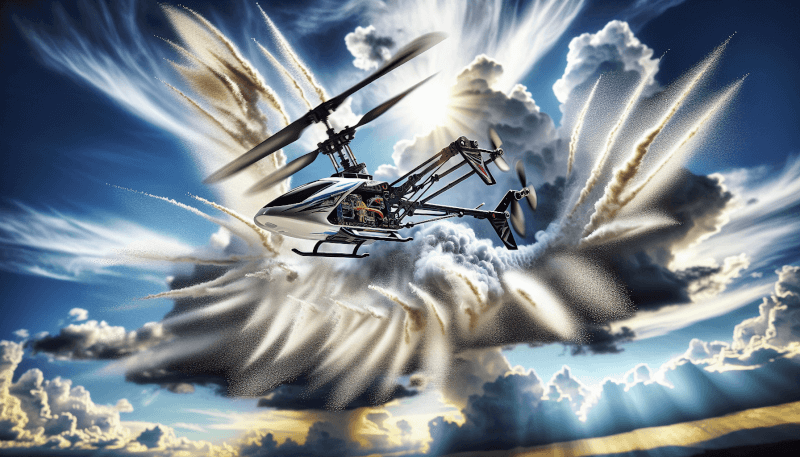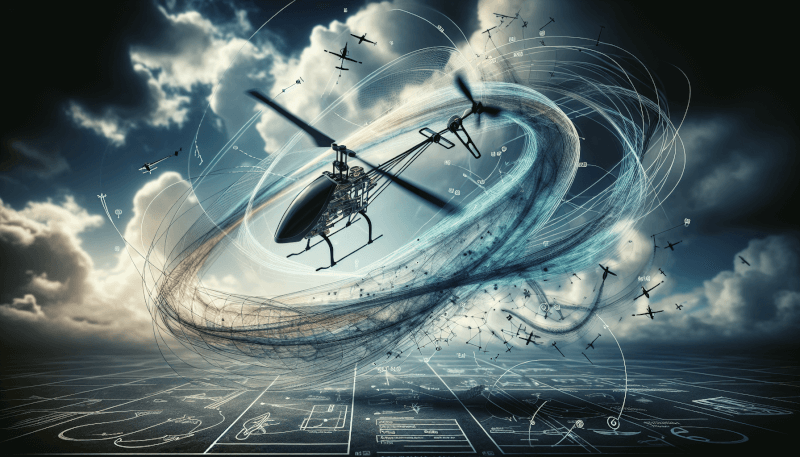Have you ever dreamed of being able to perform incredible aerial maneuvers with your RC helicopter? Well, now you can make that dream a reality by embarking on the exciting journey of learning to fly 3D with your RC helicopter. 3D flying is a challenging and exhilarating form of radio control helicopter flying that allows you to perform mind-blowing stunts and tricks in the air. In this article, we will explore the essential steps and techniques you need to master in order to become a skilled 3D pilot. Get ready to take your RC helicopter flying to new heights and impress everyone with your aerial acrobatics!
1. Choosing the Right RC Helicopter
Understanding different types of RC helicopters
When it comes to choosing the right RC helicopter, it’s important to first understand the different types available in the market. The most common types include coaxial, fixed-pitch, and collective-pitch helicopters. Coaxial helicopters are great for beginners as they provide stability and easy control. Fixed-pitch helicopters are a step up from coaxial ones, offering more maneuverability and control. Collective-pitch helicopters are the most advanced and are capable of performing 3D flight maneuvers.
Consider your skill level
Before making a decision, it’s crucial to consider your skill level as a pilot. If you’re a beginner, it’s advisable to start with a coaxial or fixed-pitch helicopter. These types are more forgiving and easier to learn on. However, if you have some experience and are looking to challenge yourself, a collective-pitch helicopter would be a better choice.
Looking at different brands and models
There are several reputable brands in the market that offer a wide range of RC helicopters. Before making a purchase, it’s a good idea to do some research and read reviews about different models. Look for brands that have a good reputation for quality and durability. Additionally, consider factors such as spare parts availability and customer support when choosing a brand.
Determining your budget
RC helicopters come in a range of prices, so it’s important to determine your budget before making a purchase. Take into account not only the cost of the helicopter itself but also additional accessories such as batteries, chargers, and spare parts. It’s always better to invest in a quality helicopter that meets your needs and fits within your budget rather than going for a cheaper option that may lead to frustration and disappointment in the long run.
2. Getting Started with Basic Flight
Understanding the controls
Before taking to the skies, it’s crucial to understand the controls of your RC helicopter. Familiarize yourself with the transmitter and learn the function of each stick, knob, or switch. The controls typically include throttle, elevator (pitch), aileron (roll), and rudder (yaw). Spend some time practicing with the controls on the ground before attempting to fly the helicopter.
Learning to hover
One of the first skills to master in basic flight is hovering. This involves maintaining a stable position in mid-air without any forward or backward movement. Start by practicing hovering close to the ground and gradually increase the altitude as you gain confidence. Focus on maintaining a steady height and position using small adjustments to the controls.
Practicing basic maneuvers
Once you feel comfortable with hovering, you can start practicing basic maneuvers such as forward flight, backward flight, and turns. Start with simple movements and gradually increase the complexity as you progress. Make sure to practice in an open space away from obstacles or people to minimize the risk of accidents.
Developing hand-eye coordination
Flying an RC helicopter requires good hand-eye coordination and reflexes. To improve these skills, it’s important to practice regularly. Set aside dedicated practice sessions to focus on hand-eye coordination exercises such as flying figure eights, flying in circles, or flying through designated markers. With consistent practice, you’ll begin to develop the necessary muscle memory and coordination for more advanced maneuvers.

3. Exploring the World of 3D Flight
Understanding 3D flight principles
3D flight is a more advanced level of flying that involves performing complex maneuvers including flips, rolls, and inverted flight. Before attempting these maneuvers, it’s important to understand the principles behind them. Learn about how different control inputs affect the helicopter’s movements and how to use collective pitch to control altitude and throttle to control speed.
Mastering advanced maneuvers
Once you have a solid understanding of the principles, you can start mastering advanced maneuvers. This may include flips, rolls, loops, and tic-tocs. Start by practicing these maneuvers at a safe altitude and gradually increase the difficulty as you gain confidence. It’s important to take it slow and focus on precision and smoothness rather than speed.
Learning to perform flips and rolls
Flips and rolls are some of the most exciting maneuvers in 3D flight. To perform a flip, start by climbing to a safe altitude and then rapidly apply negative collective pitch while simultaneously pushing the elevator stick forward. The helicopter will flip in the desired direction. Rolls, on the other hand, involve applying a combination of aileron and elevator inputs to roll the helicopter to either side.
Practicing inverted flight
Flying inverted, with the helicopter upside down, is one of the most challenging aspects of 3D flight. It requires precise control inputs and a good understanding of how the controls need to be inverted. Start by practicing inverted hovering close to the ground and gradually increase the altitude as you become more comfortable. Remember to take it slow and always prioritize safety.
4. Safety Precautions and Maintenance
Importance of pre-flight checks
Before each flight session, it’s vital to perform thorough pre-flight checks. Inspect your helicopter for any signs of damage or wear and tear. Check all the electronic connections, blades, and moving parts to ensure everything is in proper working order. Additionally, check the battery charge level and make sure all the control surfaces are functioning correctly.
Understanding safety guidelines
Flying an RC helicopter comes with inherent risks, so it’s crucial to follow safety guidelines to minimize the chance of accidents. Always keep a safe distance from people, animals, and property. Avoid flying in crowded areas or near airports. Ensure you have a clear line of sight to the helicopter at all times. Lastly, never fly your helicopter in adverse weather conditions such as strong winds or rain.
Maintaining your RC helicopter
Regular maintenance is essential to keep your RC helicopter in good working condition. After each flight session, take the time to clean the helicopter, removing any dirt, debris, or grass that may have accumulated. Check the blades for any signs of damage and replace them if necessary. It’s also important to lubricate the moving parts and tighten any loose screws.
Preventing accidents and crashes
Accidents and crashes are inevitable, especially during the learning phase. However, there are steps you can take to minimize the risk. Always fly in an open, designated area away from obstacles. Start with lower altitudes and gradually increase as you gain confidence. Be cautious when attempting new maneuvers and practice them at a safe altitude. Lastly, always keep spare parts and tools handy for quick repairs if needed.

5. Joining an RC Helicopter Flying Club
Benefits of joining a club
Joining an RC helicopter flying club offers numerous benefits for both beginners and experienced pilots. It provides a sense of community and allows you to connect with fellow enthusiasts who share the same passion. Clubs often have access to dedicated flying fields and offer organized events and competitions. It’s a great way to learn from experienced pilots, receive guidance, and exchange tips and tricks.
Learning from experienced pilots
One of the biggest advantages of joining a flying club is the opportunity to learn from experienced pilots. Many clubs offer mentoring programs or training sessions where experienced pilots can provide guidance and help you improve your flying skills. They can offer valuable insights, share their expertise, and help troubleshoot any issues you may face.
Participating in group flights
Flying with a group of like-minded individuals is an excellent way to enhance your flying experience. Group flights allow you to observe different flying styles and learn from others. It’s also a great opportunity to ask questions, seek advice, and receive feedback on your flying technique. Group flights can be a lot of fun and create a supportive and learning-oriented environment.
Sharing tips and tricks
Being part of a flying club means being part of a community that loves RC helicopters. Through discussions and interactions with other members, you can share and learn new tips, tricks, and techniques. Whether it’s a new maneuver you’ve mastered or a product recommendation, the collective knowledge within the club can greatly enhance your learning journey.
6. Upgrading Your RC Helicopter
Exploring upgrade options
As you become more proficient in flying your RC helicopter, you may consider upgrading certain components to enhance its performance. There are various upgrade options available, such as improving the servos, upgrading the motor, or installing a more advanced gyro system. Research and consult with experienced pilots or hobby shops to determine the most suitable upgrades for your specific helicopter model.
Choosing the right components
When upgrading your RC helicopter, it’s important to choose the right components that are compatible with your model. Consider factors such as weight, power requirements, and compatibility with the existing electronics. It’s always a good idea to consult with experts or experienced pilots who can provide guidance and recommendations based on their knowledge and experience.
Understanding the impact on flight performance
Upgrading components can have a significant impact on the flight performance of your RC helicopter. Upgrades such as a more powerful motor can provide increased speed and agility, while an advanced gyro system can improve stability and control. However, it’s important to understand that upgrades may also require adjustments to the flight controls and may affect the overall balance and handling of the helicopter.
Upgrading electronics and mechanics
In addition to components, you may also explore upgrading the electronics and mechanics of your RC helicopter. This could involve installing a more advanced radio system, using high-quality batteries, or upgrading the rotor head assembly. Again, it’s important to research and consult with experts to ensure compatibility and optimal performance.

7. Finding Resources and Tutorials
Online forums and communities
Online forums and communities dedicated to RC helicopters are a valuable source of information and support. These platforms allow you to connect with fellow enthusiasts, ask questions, seek advice, and share your experiences. Participating in discussions and reading through threads can provide insights into troubleshooting, equipment reviews, and flying techniques.
Video tutorials
Video tutorials are an excellent way to learn new flying techniques and gain a better understanding of various maneuvers. Many experienced pilots and RC enthusiasts share their knowledge by creating and uploading instructional videos on platforms like YouTube. These tutorials provide step-by-step instructions, visual demonstrations, and tips to help you improve your flying skills.
Books and magazines
There are numerous books and magazines available that cover various aspects of RC helicopter flying. These resources provide in-depth information about equipment, maintenance, flying techniques, and even competitions. They can be a great source of inspiration and valuable knowledge, especially for those who prefer a more comprehensive and offline learning experience.
Attending RC heli events
Attending RC helicopter events, such as airshows or competitions, can be a great way to immerse yourself in the hobby and learn from experienced pilots. These events often feature flight demonstrations, workshops, and the opportunity to interact with experts. It’s a chance to witness advanced maneuvers, gain inspiration, and connect with fellow enthusiasts. Keep an eye out for events happening in your region and make sure to mark your calendar!
8. Troubleshooting Common Issues
Identifying flight issues
At some point, every RC helicopter pilot encounters flight issues. It’s important to be able to identify and troubleshoot these issues to ensure safe and enjoyable flying. Common flight issues may include unstable hovering, unresponsive controls, or drifting during flight. Take the time to analyze the problem, consider possible causes, and make necessary adjustments to the helicopter or controller settings.
Troubleshooting mechanical problems
Mechanical problems can also arise with your RC helicopter. These could involve issues with the rotor head assembly, servo gears, or motor. If you encounter mechanical failures, start by inspecting the affected components for any damage or wear. Replace any damaged parts and ensure proper alignment and balance. Regular maintenance and lubrication can help prevent mechanical issues from occurring.
Understanding electronic failures
Electronic failures can be frustrating but are a common occurrence in the world of RC helicopters. If you experience issues such as intermittent connectivity, loss of signal, or motor cutouts, it’s important to check the battery, transmitter, and receiver connections. Ensure all the connections are secure and free from corrosion. If the problem persists, it may be necessary to replace faulty electronics or consult with an expert for further diagnosis.
Seeking help from experienced pilots
If you’re unable to troubleshoot an issue on your own, don’t hesitate to seek help from experienced pilots or join an RC helicopter forum or community. Others may have encountered similar problems and can offer advice or solutions. Experienced pilots can also provide guidance on identifying and resolving more complex issues. Remember, the RC helicopter community is a friendly and supportive one, always willing to help fellow enthusiasts.

9. Competing in RC Helicopter Competitions
Preparing for competitions
Competing in RC helicopter competitions is an exciting way to showcase your skills and challenge yourself. To prepare, it’s important to practice regularly and focus on mastering the required maneuvers for the competition. Set goals, create a practice routine, and seek feedback from experienced pilots. Additionally, make sure your helicopter is in optimal condition and that you have spare parts and tools readily available for any necessary repairs.
Understanding competition rules
Each competition may have specific rules and guidelines that participants must follow. Familiarize yourself with these rules to understand the scoring criteria, time limits, and any restrictions on maneuvers or equipment. Understanding the rules ensures that you can prepare and practice accordingly, increasing your chances of success.
Building a routine
Competitions often require participants to perform a routine consisting of predetermined maneuvers within a specific time frame. Building a routine involves selecting and practicing a sequence of maneuvers that best showcases your skills. Consider the difficulty level, flow of the routine, and your ability to execute each maneuver with precision. Practice the routine repetitively to build muscle memory and develop consistency.
Scoring and judging criteria
During competitions, your performance will be scored and judged based on specific criteria. These may include factors such as execution, difficulty, precision, and creativity. Judges will assess each maneuver based on these criteria and assign scores accordingly. Understanding the scoring and judging criteria helps you tailor your routines and maximize your chances of achieving a higher score.
10. Pushing the Limits with Advanced Techniques
Learning advanced maneuvers
Once you have mastered the basics of 3D flight, it’s time to push the limits and learn more advanced maneuvers. This may include tricks like piro flips, hurricane maneuvers, and chaos maneuvers. Advanced maneuvers require precise control inputs, timing, and a deep understanding of the helicopter’s capabilities. Take it one step at a time, practice consistently, and seek guidance from experienced pilots to master these challenging maneuvers.
Exploring extreme 3D flight
Extreme 3D flight takes the concept of 3D flight to a whole new level. It involves pushing the helicopter to its limits, performing high-speed, high-energy maneuvers that test both the pilot’s skills and the capabilities of the helicopter. Extreme 3D flight often includes aggressive flips, rolls, and inverted maneuvers executed with incredible precision and speed. This level of flying requires not only advanced piloting skills but also a thorough understanding of the helicopter’s mechanics and setup.
Mastering autorotations
Autorotations are a critical skill for every RC helicopter pilot to master. This technique allows the helicopter to safely land in the event of a power failure. By using the stored energy in the rotor blades, the pilot can control the descent and perform a controlled landing. Mastering autorotations requires practice and a solid understanding of the correct inputs and timing. It’s an essential skill that adds an extra layer of safety and confidence to your flying.
Pushing the performance boundaries
As you become more proficient in 3D flight, you may want to explore ways to push the performance boundaries of your RC helicopter. This could involve experimenting with different setups, adjusting the center of gravity, or fine-tuning the rotor blade pitch and length. However, it’s important to proceed with caution and make changes gradually. Remember that pushing the performance boundaries comes with increased risks, so prioritize safety at all times.
Learning to Fly 3D with Your RC Helicopter is an exciting and rewarding journey. By understanding different types of RC helicopters, considering your skill level, and researching different brands and models, you can choose the right helicopter for your needs. Starting with basic flight, mastering controls, and practicing maneuvers will help you build a solid foundation. Progressing into 3D flight requires a deep understanding of the principles, mastering advanced maneuvers, and practicing inverted flight. Safety precautions, maintenance, and joining an RC helicopter flying club provide a supportive and educational environment. Upgrading your RC helicopter can enhance performance, and finding resources in the form of online forums, tutorials, books, and events will help expand your knowledge. Troubleshooting issues, competing in competitions, and mastering advanced techniques take your flying skills to the next level. So, strap in and get ready to experience the thrill and joy of flying 3D with your RC helicopter!



